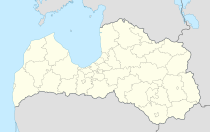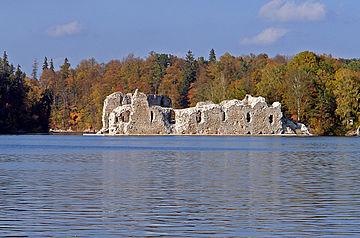Cocaine
| Koknese ( German : Kokenhusen) | ||
|---|---|---|
 |
|
|
| Basic data | ||
| State : |
|
|
| Landscape: | Livonia ( Latvian : Vidzeme ) | |
| Administrative district : | Kokneses novads | |
| Coordinates : | 56 ° 39 ' N , 25 ° 26' E | |
| Residents : | 2,818 (Jun 3, 2015) | |
| Area : | ||
| Population density : | ||
| Height : | 89 m | |
| City law: | since 1277 | |
| Website: | www.koknese.lv | |
| Post Code: | ||
| ISO code: | ||
| Kokenhusen castle ruins | ||
Koknese (German: Kokenhusen ; Russian: Кукейнос ) is a former Hanseatic city in Latvia . It is located on the right bank of the Daugava , about 100 kilometers east of Riga .
history
Originally there was a Latgallic and Selonian settlement called "Kukenois" on the site of Koknese . Around the late 12th century, this was a sub-principality of the Russian principality of Polotsk . At the beginning of the 13th century the German crusaders of the Brothers of the Sword began to occupy the coasts of the Riga Bay under the leadership of Albert von Buxhövden . The Russian governor Vyachko gave half of his land to the Crusaders in 1207 and received the Kukenois as a fief. In 1209 the area was completely taken over by the order. Albert then ordered the construction of a brick castle to replace the wooden fortifications used by the Latvians at the confluence of the Daugava and Pērse rivers . The formal rule of Polotsk was revoked in 1215. In 1238 the area fell to the Archbishop of Riga . Kokenhusen Castle was part of the strategic chain of castles Dünamünde-Riga-Holme-Üexküll-Lennewarden along the Düna .
A settlement developed around the castle, which received city rights in 1277 . The city thrived as part of the Hanseatic League during the 14th century . Kokenhusen was a frequent subject of dispute between the bishops and the von Tiesenhausen family , to whom it had been given as a fief in 1269. The Teutonic Order supported the claims of the Tiesenhausen in order to weaken the episcopal power. Archbishop Johann V. von Wallenrodt managed to settle the dispute and win the area back for the church in 1397. In 1420 Kokenhusen Castle became the summer residence of the Archbishops of Riga and their headquarters in the 16th century.
During the Livonian War , the army of the Russian Tsar Ivan IV the Terrible invaded the area in 1577, devastating the city and abducting the inhabitants. In 1582 the place came to Poland-Lithuania .
Also in the 17th century, during the wars between Poland, Russia and Sweden , the city changed hands several times. In 1601 the Battle of Kokenhusen took place here, in which the hussars of the Polish cavalry defeated their Swedish opponents. However, in 1629 the city became part of the Swedish possessions and fortified again. After further years of war, the city was almost completely deserted in 1684.
During the Great Northern War , the castle was finally captured and blown up by Saxon troops when they had to retreat from the advancing Swedes. After the provisions of the Peace of Nystad , Kokenhusen became part of Russia with the rest of Livonia in 1721 .
A railway line that crossed Kokenhusen was completed in 1861, and the town has now also become a resort for townspeople. The Baltic German family of the Barons von Löwenstern built a stately castle in the neoclassical style, which was completed in 1894, but destroyed during the First World War. During the 1905 Revolution , the rebels used the manor's basement as a prison for the noble family. After Latvian independence from Russia in 1918, the city became known under its Latvian name "Koknese". A meeting place of the local Intelligentsia was given the name "Professorenhügel".
The construction of the Pļaviņas hydroelectric power station began in 1966 and caused the foundation walls of the castle ruins to sink into the water.
Others
- The Latvian playwright Rūdolfs Blaumanis lived in the city in the 1880s.
- The Latvian painter Julius Fedders (1838–1909) was born here.
- The Koknese Castle Park, which surrounds part of the medieval town and castle ruins, is home to the country's largest wooden sculpture. It was built by Ģirts Burvis using trees from the park and inaugurated on the 725th anniversary of the city's foundation in 2002.
- Koknese is a member of the new Hanseatic League , an association that has set itself the goal of developing the economy and tourism in its participating cities.
Kokneses novads
In the course of an administrative reform, the municipalities of Bebri, Irši and Koknese were merged. In 2010 there were 6,036 registered residents.
literature
- Hans Feldmann , Heinz von zur Mühlen (Hrsg.): Baltic historical local dictionary, part 2: Latvia (southern Livland and Courland). Böhlau, Cologne 1990, ISBN 3-412-06889-6 , pp. 292-293.
- Astrīda Iltnere (ed.): Latvijas Pagasti, Enciklopēdija. Preses Nams, Riga 2002, ISBN 9984-00-436-8 .
Web links
- The Koknese park ( Memento from July 17, 2012 in the Internet Archive )


